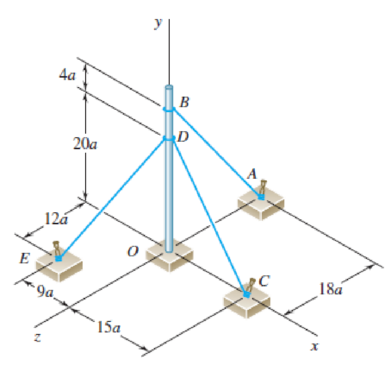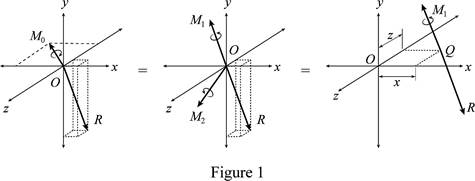
A flagpole is guyed by three cables. If the tensions in the cables have the same magnitude P, replace the forces exerted on the pole with an equivalent wrench and determine (a) the resultant force R, (b) the pitch of the wrench, (c) the point where the axis of the wrench intersects the xz-plane.

(a)
The resultant force.
Answer to Problem 3.140P
The resultant force is
Explanation of Solution
The diagram for the force-couple system is given below:

Refer fig 1.
Write the equation of resultant force.
Here, the resultant force is
Conclusion:
Substitute,
The magnitude of the resultant force,
Thus, the resultant force is
(b)
The pitch of the wrench.
Answer to Problem 3.140P
The pitch of the wrench is
Explanation of Solution
Write the equation of pitch of the wrench.
Here, the pitch of the wrench is
Since, the
Here, the constant is
Write the expression for the constant is,
Write the equation of momentum.
Here, the momentum is
Rewrite the expression for the momentum of the wrench is,
Conclusion:
Substitute,
Substitute,
Thus, the pitch of the wrench is
(c)
The point at which the axis of wrench intersects the xz-plane.
Answer to Problem 3.140P
The axis of wrench intersects the xz-plane at
Explanation of Solution
Refer fig 1,
Write the equation for the force couple system for the wrench.
Here, the momentum is
Write the expression for the momentum at which the wrench intersects the xz-plane.
Here, the position vector is
Write the expression for the position vector is,
Here, the coordinates are
Conclusion:
Substitute,
Substitute,
Substitute,
Comparing the coefficients of the x and z components both sides,
Therefore, he axis of wrench intersects the xz-plane at
Want to see more full solutions like this?
Chapter 3 Solutions
VECTOR MECHANICS FOR ENGINEERS: STATICS
- My ID# 016948724 please solve the proble step by step find the forces fx=o: fy=0; fz=0; and find shear moment and the bending moment diagran please draw the diagram for the shear and bending momentarrow_forwardMy ID#016948724. Please help me to find the moment of inertia lx ly are a please show to solve step by stepsarrow_forwardplease solve this problem step by steparrow_forward
- Please do not use any AI tools to solve this question. I need a fully manual, step-by-step solution with clear explanations, as if it were done by a human tutor. No AI-generated responses, please.arrow_forwardPlease do not use any AI tools to solve this question. I need a fully manual, step-by-step solution with clear explanations, as if it were done by a human tutor. No AI-generated responses, please.arrow_forwardPlease do not use any AI tools to solve this question. I need a fully manual, step-by-step solution with clear explanations, as if it were done by a human tutor. No AI-generated responses, please.arrow_forward
- [Q2]: The cost information supplied by the cost accountant is as follows:Sales 20,00 units, $ 10 per unitCalculate the (a/ newsale guantity and (b) new selling price to earn the sameVariable cost $ 6 per unit, Fixed Cost $ 30,000, Profit $ 50,000profit ifi) Variable cost increases by $ 2 per unitil) Fixed cost increase by $ 10,000Ili) Variable cost increase by $ 1 per unit and fixed cost reduces by $ 10,000arrow_forwardcan you please help me perform Visual Inspection and Fractography of the attatched image: Preliminary examination to identify the fracture origin, suspected fatigue striation, and corrosion evidences.arrow_forwardcan you please help[ me conduct Causal Analysis (FTA) on the scenario attatched: FTA diagram which is a fault tree analysis diagram will be used to gain an overview of the entire path of failure from root cause to the top event (i.e., the swing’s detachment) and to identify interactions between misuse, material decay and inspection errors.arrow_forward
 International Edition---engineering Mechanics: St...Mechanical EngineeringISBN:9781305501607Author:Andrew Pytel And Jaan KiusalaasPublisher:CENGAGE L
International Edition---engineering Mechanics: St...Mechanical EngineeringISBN:9781305501607Author:Andrew Pytel And Jaan KiusalaasPublisher:CENGAGE L
